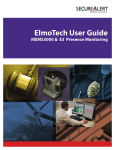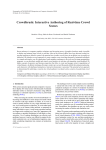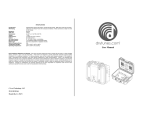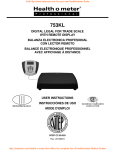Download EXHIBIT 1037: MEMS 3000 USER MANUAL
Transcript
EXHIBIT 1037: MEMS 3000 USER MANUAL Alcohol Monitoring Systems, Inc.: EXHIBIT 1037 REQUEST FOR INTER PARTES REVIEW OF U.S. PATENT NUMBER 8,381,573 Cellular Receiver and Transmitter Installation Guide AMS Exhibit 1037-1 AMS v. Soberlink IPR2013-00577 Information in this documentation is subject to change without notice and does not represent a commitment on part of Elmo-Tech Ltd. The software described in this document is subject to the license agreement that is included with the product, which specifies the permitted and prohibited uses of the product. Any unauthorized duplication or use of this documentation, in whole or in part, in print, or in any other storage or retrieval system is prohibited. No part of this publication may be reproduced, transmitted, transcribed, stored in a retrieval system, or translated into any language in any form by any means for any purpose other than the purchaser’s personal use without the permission of Elmo-Tech Ltd. © 2002-08 Elmo-Tech Ltd. All rights reserved. Unless otherwise noted, all names of companies, products, street addresses, and persons contained herein are part of a completely fictitious scenario and are designed solely to document the use of an Elmo-Tech product. Contact Us Corporate Headquarters Elmo-Tech Ltd. 2 Ha-Barzel St., P.O. Box 13236, 61132 Tel Aviv, Israel Tel: 972-3-7671800 Fax: 972-3-7671801 U.S.A Customers, call 1-800-313-1483 E-mail: [email protected] Visit us at: www.elmotech.com AMS Exhibit 1037-2 AMS v. Soberlink IPR2013-00577 FCC Information FCC ID: LSQ-MEMS-3000-GSM FEDERAL COMMUNICATIONS COMMISSION (FCC) Part 15 STATEMENT This equipment has been tested to FCC requirements and has been found acceptable for use. The FCC requires the following statement for your information. This equipment generates and uses radio frequency energy and if not installed and used properly, that is, in strict accordance with the manufacturer’s instructions, may cause interference to radio and television reception. It has been type tested and found to comply with the limits for a Class B computing device in accordance with the specifications in Part 15 of FCC Rules, which are designed to provide reasonable protection against such interference in a residential installation. However, there is no guarantee that interference will not occur in a particular installation. If this equipment does cause interference to radio or television reception, which can be determined by turning the equipment off and on, the user is encouraged to try to correct the interference by one or more of the following measures: f If using an indoor antenna, have a quality outdoor antenna installed. f Reorient the receiving antenna until interference is reduced or eliminated. f Move the receiver away from the control/communicator. f Move the antenna leads away from any wire runs to the control/ communicator. f Plug the control/communicator into a different outlet so that it and the receiver are on different branch circuits. If necessary, the user should consult the dealer or an experienced radio/television technician for additional suggestions. AMS Exhibit 1037-3 AMS v. Soberlink IPR2013-00577 The user or installer may find the following booklet prepared by the Federal Communications Commission helpful: “Interference Handbook”. This booklet is available from the U.S. Government Printing Office, Washington, DC 20402. The user shall not make any changes or modifications to the equipment unless authorized by the Installation Instructions or User’s Manual. Unauthorized changes or modifications could void the user’s authority to operate the equipment. AMS Exhibit 1037-4 AMS v. Soberlink IPR2013-00577 Table of Contents 1 Introduction.................................................................... 1 2 Installing the MEMS3000 Receiver.................................. 3 Before Installation............................................................. 3 Installation Equipment .................................................. 3 Installation Tools.......................................................... 4 Offender Information in the MWS.................................... 4 Placing the Receiver .......................................................... 4 Positioning the Receiver ..................................................... 6 Installing the Receiver ....................................................... 7 3 Calibrating and Attaching the Transmitter ...................... 9 Calibrating the Transmitter................................................. 9 Attaching the Transmitter .................................................10 4 Activating the Offender’s Monitoring Program .............. 13 Downloading the Program Configuration..............................13 Performing a Range Test ...................................................14 Performing an Alcohol / Picture Enrollment ..........................16 Leaving the Offender’s Curfew Site .....................................17 General Rules for the Offender...........................................17 5 Performing an On-Demand Test .................................... 19 6 Responding to Strap Tampering Events ........................ 21 i AMS Exhibit 1037-5 AMS v. Soberlink IPR2013-00577 MEMS3000 Cellular (VBR) Installation Guide 7 Dismantling the MEMS3000 Equipment ......................... 23 Before Dismantling...........................................................23 Performing an End of Service.............................................23 Disconnecting and Packing the MEMS3000 Receiver ..............24 Removing the Transmitter.................................................24 Deactivating and Packing the Transmitter ............................25 8 System Maintenance ..................................................... 27 Cleaning the MEMS3000 Receiver.......................................27 Cleaning the Transmitter...................................................28 Manually Cleaning the Transmitter ................................. 28 Cleaning the Transmitter Using a Dishwasher .................. 29 Replacing the Transmitter Straps .......................................30 Required Equipment .................................................... 30 Replacing the Straps .................................................... 31 ii AMS Exhibit 1037-6 AMS v. Soberlink IPR2013-00577 List of Figures List of Figures Figure 1 Placing the MEMS3000 Receiver ..................................... 5 Figure 2 Positioning the MEMS3000 Receiver ................................ 6 Figure 3 Installing the MEMS3000 Receiver .................................. 7 Figure 4 Performing an On-Demand Test.....................................19 Figure 5 Dismantling the Transmitter Clip....................................24 iii AMS Exhibit 1037-7 AMS v. Soberlink IPR2013-00577 AMS Exhibit 1037-8 AMS Exhibit 1037-8 AMS v. Soberlink AMS v. Soberlink IPR2013-00577 IPR2013-00577 1 Introduction Welcome to the Electronic Monitoring System and correctional tool, created by Elmo-Tech Ltd., that has the ability to collect, analyze, and intelligently act on information from multiple sources. An inconspicuous Transmitter (TX) is attached to the client's ankle or wrist by means of a tamper-detecting strap. The client's presence (or absence) is tracked constantly by radio transmissions between the Transmitter and the MEMS3000 Receiver. When the client enters or leaves the defined home environment, the MEMS3000 Receiver records the event. The MEMS3000 Receiver then checks the client’s stored curfew schedule to determine if the event is in violation of his or her curfew order. The MEMS3000 Receiver is a highly efficient monitoring unit, integrating alcohol testing (BAT), video identity verification, and radio frequency presence monitoring into a single unit. The MEMS3000 Receiver transfers the breath alcohol test results and client’s image to the monitoring center by means of cellular communication (Data or GPRS). The MEMS3000 Receiver reports certain violations to the monitoring center as soon as they occur. Other violation and non-violation events that are not defined as immediate are stored in the MEMS3000 Receiver for the next upload. The MEMS3000 Receiver initiates a pre-defined routine sanity call to the monitoring center in order to report the status of the equipment and upload stored events. This event information completes the audit trail of the client’s behavior. The MEMS3000 Receiver detects and reports tilting, loss of power, loss of cellular coverage, low battery, and other alarm conditions. The MEMS3000 Receiver also detects Transmitter tampering, removal, and low battery. 1 AMS Exhibit 1037-9 AMS v. Soberlink IPR2013-00577 AMS Exhibit 1037-10 AMSAMS Exhibit 1037-10 v. Soberlink AMS v. Soberlink IPR2013-00577 IPR2013-00577 2 Installing the MEMS3000 Receiver Installing the MEMS3000 Receiver involves: f Assembling the appropriate equipment f Verifying that the Offender is registered in the MWS software f Locating the optimal place and position for the unit in the Offender’s curfew site f Setting up the unit Before Installation Before leaving the monitoring center, check that you have the correct installation kit and the appropriate installation tools. In addition, verify that the Offender is correctly registered in the MWS software application. Installation Equipment The kit of installation equipment should include the following items: f MEMS3000 Receiver f Power adapter f Breath tube f Transmitter with strap holder f Locking clip(s) 3 AMS Exhibit 1037-11 AMS v. Soberlink IPR2013-00577 MEMS3000 Cellular (VBR) Installation Guide Installation Tools You will also need the following installation tools: f Manual Reset Device (MRD)– for activating the Transmitter f Strap locking tool – for locking the Transmitter f 0.2” (5mm) flat head screwdriver – for opening the locking clip f Snake eye screwdriver – for changing the straps on the Transmitter Offender Information in the MWS Verify the following Offender details in the MWS software application: f Offender’s name and address f Offender’s program type – MEMS3000 VBR, Cellular f Equipment serial numbers – these must match the serial numbers on the equipment you are planning to install f SIM card details For more information about working with the MWS system, refer to the E3-MWS Monitor Operator’s Manual. Placing the Receiver The ideal location for the MEMS3000 Receiver is: f In an open area f As close as possible to the center of the curfew site f On a flat and secure surface f 3 ft (1m) above the ground and at least 1 ft (30cm) away from the wall 4 AMS Exhibit 1037-12 AMS v. Soberlink IPR2013-00577 2 Installing the MEMS3000 Receiver Make sure the MEMS3000 Receiver is located far away from: f Television sets or other electrical appliances f Microwave ovens f Personal computers or laptops f Disruptive noise sources such as heavy traffic or mechanical vibrations f Heat sources such as a radiator, air duct, or direct sunlight f Excessive moisture or extremely low temperatures f Mirrors or reflective materials Figure 1 Placing the MEMS3000 Receiver 5 AMS Exhibit 1037-13 AMS v. Soberlink IPR2013-00577 MEMS3000 Cellular (VBR) Installation Guide Positioning the Receiver Always position the MEMS3000 Receiver in a well lit room with the mirror panel facing away from any direct light (as indicated by the in the diagram below ). 3 Direct light in front of the mirror or any backlighting behind the person whose picture is taken (as indicated by the × in the diagram below) may cause severe reflections in the picture. Figure 2 Positioning the MEMS3000 Receiver After the MEMS3000 Receiver has been positioned correctly, you can start the installation and activation process. 6 AMS Exhibit 1037-14 AMS v. Soberlink IPR2013-00577 2 Installing the MEMS3000 Receiver Installing the Receiver After you locate a suitable location for the MEMS3000 Receiver, connect the unit to a power source and set up the breath tube. Figure 3 Installing the MEMS3000 Receiver 1. Insert the appliance end of the supplied power adapter cord into the power socket located on the back panel of the MEMS3000 Receiver. 2. Insert the adapter end of the supplied power adapter cord into a power outlet. The MEMS3000 Receiver emits a beeping sound and the PWR LED located on the back panel turns on, indicating that the external power is connected. 7 AMS Exhibit 1037-15 AMS v. Soberlink IPR2013-00577 MEMS3000 Cellular (VBR) Installation Guide After the MEMS3000 Receiver connects to the cellular network, the GSM Network LED located on the back panel turns on. The process of connecting to the cellular network may take up to a minute. The MEMS3000 Receiver automatically switches to Standby mode. 3. Place the short side of the breath tube into the tube holder located in the center of the MEMS3000 Receiver. 8 AMS Exhibit 1037-16 AMS v. Soberlink IPR2013-00577 3 Calibrating and Attaching the Transmitter You must calibrate the Transmitter before you can attach the Transmitter around the Offender’s wrist or ankle. Calibrating the Transmitter 1. Hold the free end of the Transmitter strap in your hand with the metal pins pointing towards you. 2. Hold the MRD in your other hand, with the two connection points facing the metal pins. 3. Press the metal pins on the Transmitter onto the two connection points on the MRD and hold them in this position. 4. On the MRD, press On. The red LED on the MRD turns on for 2 seconds and then flashes for another 2 seconds. The flashing indicates that the Transmitter has passed the first phase of its calibration. Note: If the Transmitter failed to receive the calibration command, the red LED on the MRD turns off after initially being on for two seconds. If the MRD’s battery is low, the red LED flashes for two seconds immediately after the ON button is pressed. 5. After the red LED flashes, place the Transmitter on its side on a non-metal surface. 6. Wait for at least 60 seconds. The MEMS3000 Receiver emits a beeping sound, indicating that the Calibration was successful. The Transmitter is now activated. 9 AMS Exhibit 1037-17 AMS v. Soberlink IPR2013-00577 MEMS3000 Cellular (VBR) Installation Guide Note: The MEMS3000 Receiver emits a beep and the RF LED flashes every time a signal is received from the Transmitter while the Receiver is in Standby mode. Standby mode ends after: • The Transmitter strap is closed on the Offenders wrist or ankle for at least one minute and the Receiver locks onto the Transmitter. The Receiver is now in Lock mode. • The Receiver receives a successful download from the monitoring center. The Receiver is now in Monitor mode. Attaching the Transmitter 1. Place the strap holder over the short strap of the Transmitter. 2. Attach the female part of the clip to the underside of the short strap ensuring that the closed end of the clip fits snugly onto the end of the strap. 3. Wrap the Transmitter around the wrist or ankle at its narrowest point. 10 AMS Exhibit 1037-18 AMS v. Soberlink IPR2013-00577 3 Calibrating and Attaching the Transmitter 4. Lay the long strap over the female part of the clip ensuring that the strap pins and the clip studs are protruding through the holes in the long strap. 5. Slide the strap holder over the end of the long strap in order to hold the strap in place 6. Move the Transmitter around the wrist or ankle to ensure that it fits comfortably. 7. Place the male part of the clip over the female part, ensuring that the grooves on each side of the clips match. 8. Place one side of the locking tool underneath the clip and close the two parts together. A clicking sound should be heard, indicating that the clip is properly locked. After the Transmitter has been attached for at least one minute, the Receiver locks onto the Transmitter. Until the Receiver receives a download of the Offender’s program configuration from the monitoring center, the Receiver is in Lock mode and monitors the Offender’s activity according to the factory default settings. When the Receiver receives a successful download, the Offender’s monitoring records during Lock mode are uploaded to the monitoring center. Remember: Be sure to collect all the installation equipment at the Offender’s curfew site. This includes any locking clips that may have broken during the installation. 11 AMS Exhibit 1037-19 AMS v. Soberlink IPR2013-00577 AMS Exhibit 1037-20 AMSAMS Exhibit 1037-20 v. Soberlink AMS v. Soberlink IPR2013-00577 IPR2013-00577 4 Activating the Offender’s Monitoring Program After installing the monitoring equipment, you can download the Offender’s program configuration and perform a range test. Downloading the Program Configuration 1. Verify that the GSM Network LED on the MEMS3000 Receiver back panel is on and not flashing (Figure 3). If the GSM Network LED is flashing, the line is busy. Wait until the light stops flashing and proceed with the download procedure. 2. Call the monitoring center personnel to request a manual download. The following sequence occurs: a. After the download is initiated the GSM Network LED begins flashing, indicating that the download call is being received. b. After the download call has been completed, the GSM Network LED returns to its steady state. c. The MEMS3000 Receiver switches to Monitor mode. 3. Call the monitoring center personnel to request confirmation that the download was successful. If the download was not successful, repeat the download procedure. 13 AMS Exhibit 1037-21 AMS v. Soberlink IPR2013-00577 MEMS3000 Cellular (VBR) Installation Guide Performing a Range Test After the Offender’s program configuration has been successfully downloaded and the MEMS3000 Receiver is in Monitor mode, you can perform a range test. The range test is designed to verify that the MEMS3000 Receiver’s range setting is sufficient to receive signals from the Transmitter throughout the Offender’s curfew site. Therefore, while performing a range test you should escort the Offender to the following types of locations: f Places where the Offender may be located for long periods of time, such as the living room, bedroom, or bathroom f Remote locations where the Offender is permitted, such as the garage, cellar, or backyard f The places in the curfew site that are furthest from the Receiver f Behind large metal objects Since the MEMS3000 Receiver automatically terminates the range test after approximately 15 minutes, it is recommended that you examine the curfew site before starting the test in order to determine the relevant test locations ahead of time. 1. Verify that the GSM Network LED on the MEMS3000 Receiver is on and not flashing (Figure 3). If the GSM Network LED is flashing, the line is busy. Wait until the light stops flashing and proceed with the range test procedure. 14 AMS Exhibit 1037-22 AMS v. Soberlink IPR2013-00577 4 Activating the Offender’s Monitoring Program 2. Call the monitoring center personnel to request a range test. After the range test is initiated the Receiver’s GSM Network LED begins flashing, indicating that the range test call is being received. After the request has been received, the RF LED begins flashing. Each flash is accompanied by a beeping sound. This indicates that the MEMS3000 is successfully receiving RF signals from the Transmitter and the range test has begun. Note: The MEMS3000 Receiver automatically terminates the range test after approximately 15 minutes. You must complete the range test procedure before this time elapses. 3. Escort the Offender around the curfew site. Wait to hear at least four beeps in each test location to verify that the Transmitter’s signals are successfully reaching the Receiver. It should take about 1½ minutes to hear the four beeps. Remember: As long as the Transmitter’s signals are successfully reaching the Receiver, the Receiver’s RF LED flashes and the Receiver emits a beep approximately once every 20 seconds. 4. If you do not hear a beep from the Receiver after waiting about one minute in a test location, the Transmitter’s signals are not reaching the Receiver in that location. Call the monitoring center and request an increase in the Receiver’s range. If the Receiver is already at the maximum range setting, find a new place for the Receiver so that the furthest test location is within range. 15 AMS Exhibit 1037-23 AMS v. Soberlink IPR2013-00577 MEMS3000 Cellular (VBR) Installation Guide 5. After you test the range in all the relevant locations, call the monitoring center personnel and request an end to the current range test. After the range test call ends, the Receiver’s RF LED turns off. Performing an Alcohol / Picture Enrollment After the Offender’s program configuration has successfully downloaded, the range test is complete, and the MEMS3000 Receiver is in monitoring mode, you can enroll the Offender into the alcohol monitoring program. 1. Verify that the GSM Network LED on the MEMS3000 Receiver is on and not flashing (Figure 3). If the GSM Network LED is flashing, the line is busy. Wait until the light stops flashing and proceed with the enrollment procedure. 2. Call the monitoring center personnel to request an Offender alcohol / picture enrollment. After the alcohol / picture enrollment request is initiated, the following sequence occurs: a. The GSM Network LED begins flashing, indicating that the enrollment call is being received. b. The GSM Network LED returns to its steady state after the enrollment call has been completed. c. After a delay of up to several minutes, the Receiver emits a beeping sound, indicating that the Offender should perform an initial on-demand test. 3. Instruct the Offender to follow the procedure for an on-demand test. For more information, refer to the section Performing an On-Demand Test on page 19. 16 AMS Exhibit 1037-24 AMS v. Soberlink IPR2013-00577 4 Activating the Offender’s Monitoring Program 4. After the Test Completed LED turns on and you hear the Test Complete beeping sound, call the monitoring center personnel and request confirmation that the enrollment was successful. If the enrollment was not successful, repeat the alcohol / picture enrollment procedure. Leaving the Offender’s Curfew Site Make sure you do not leave any equipment or installation tools in the Offender’s home, including the MEMS3000 Receiver carrying case. General Rules for the Offender After all equipment has been installed and the Offender’s monitoring program has been activated, remind the Offender of the following rules: f Never touch or move the MEMS3000 Receiver f Never place any objects on top of the MEMS3000 Receiver f Never disconnect the power cord from either the MEMS3000 Receiver or the wall socket f Never attempt to open the MEMS3000 Receiver f Always stay inside the designated curfew area during an in-house curfew time frame f Never attempt to open the Transmitter strap f Never cut or break the Transmitter strap 17 AMS Exhibit 1037-25 AMS v. Soberlink IPR2013-00577 AMS Exhibit 1037-26 AMSAMS Exhibit 1037-26 v. Soberlink AMS v. Soberlink IPR2013-00577 IPR2013-00577 5 Performing an On-Demand Test During the monitoring program, the Offender receives on-demand alcohol test requests of the following types: f Scheduled tests according to the predefined test schedule downloaded to the MEMS3000 Receiver f Manual tests from the monitoring center When the Offender performs an on-demand test, the Receiver emits the Test Request beep and the Press Start LED turns on. Figure 4 Performing an On-Demand Test 19 AMS Exhibit 1037-27 AMS v. Soberlink IPR2013-00577 MEMS3000 Cellular (VBR) Installation Guide The Offender must perform the following procedure according to the progression of the Operation Panel LEDs. 1. Position yourself in front of the MEMS3000 Receiver so that the reflection of your eyes in the Mirror Panel is aligned with the upper-side LEDs surrounding the panel. If possible, your forehead and hair should be included in the Mirror Panel reflection. Note: Make sure that no direct light sources are shining on the Mirror Panel. 2. Press Start. Both the Face the Mirror and Blow LEDs turn on. 3. Blow forcefully into the breath tube. If you did not blow with enough force, the MEMS3000 Receiver emits a beep and the Blow Harder LED turns on. Blow again with greater force. After you have blown into the breath tube successfully, the Test Completed LED turns on and the MEMS3000 Receiver emits a beeping sound, indicating that the on-demand test is complete. 20 AMS Exhibit 1037-28 AMS v. Soberlink IPR2013-00577 6 Responding to Strap Tampering Events If the monitoring center detects a Strap Tampering event for the Offender’s Transmitter, the Transmitter must be reset. Tampering events can be caused by the following issues: f The Offender tried to cut, open, or otherwise tamper with the Transmitter f The Transmitter straps are defective The following procedure enables you to determine the cause of the Strap Tamper event and take the appropriate actions. 1. Remove the Transmitter from the Offender. 2. Check the Transmitter for the following signs of tampering: f Cracks on the clip f Broken pins f Tearing in the straps f Cracks on the Transmitter body If one or more of these signs are present, replace the relevant pieces. For more information about replacing the straps, refer to Replacing the Transmitter Straps on page 30. 21 AMS Exhibit 1037-29 AMS v. Soberlink IPR2013-00577 MEMS3000 Cellular (VBR) Installation Guide 3. Recalibrate the Transmitter. For more information, refer to Calibrating the Transmitter on page 9. f If the recalibration is successful, reattach the Transmitter to the Offender’s wrist or ankle. For more information, refer to Attaching the Transmitter on page 10. f If the recalibration is unsuccessful, the Transmitter is faulty. Either the straps or the whole Transmitter must be replaced. 22 AMS Exhibit 1037-30 AMS v. Soberlink IPR2013-00577 7 Dismantling the MEMS3000 Equipment Dismantling the MEMS3000 equipment involves: f Performing an End of Service, when applicable f Disconnecting and packing the Receiver f Removing, deactivating, and packing the Transmitter Before Dismantling Before leaving the monitoring center, check that you have the following dismantling tools: f Manual Reset Device (MRD)– for deactivating the Transmitter f 0.2” (5mm) flat head screwdriver – for opening the Transmitter clip In addition, make sure to bring the original carrying case for the MEMS3000 Receiver and Transmitter. Performing an End of Service In some cases, it is required to remove the MEMS3000 Receiver and Transmitter before the Offender’s defined confinement period is completed. In this case, you must perform a manual end of service procedure before disconnecting and removing the MEMS3000 equipment. Note: Perform an end of service before disconnecting and removing the MEMS3000 Receiver to preserve the unit’s internal backup battery. 23 AMS Exhibit 1037-31 AMS v. Soberlink IPR2013-00577 MEMS3000 Cellular (VBR) Installation Guide 1. Call the monitoring center and ask the monitoring personnel to perform a manual end of service. 2. The monitoring center personnel will call back to confirm a successful end of service. You can now disconnect and pack the MEMS3000 Receiver into its original package. Disconnecting and Packing the MEMS3000 Receiver 1. Unplug the power adapter cord from the wall and from the MEMS3000 Receiver. 2. Pack the MEMS3000 Receiver into its original carrying case. 3. Pack the power adapter cord into the original carrying case. Removing the Transmitter After disconnecting and packing the Receiver, you can remove the Transmitter. 1. Being careful not to damage or cut the strap, insert a screwdriver into the grooves of the clip and gently pry the clip pieces apart. Figure 5 Dismantling the Transmitter Clip 2. Collect all the fragments of the broken clip. Do not leave any disposable items. 24 AMS Exhibit 1037-32 AMS v. Soberlink IPR2013-00577 7 Dismantling the MEMS3000 Equipment Deactivating and Packing the Transmitter Deactivating the Transmitter is essential to preserving the unit’s internal battery. 1. Hold the Transmitter along the strap with the metal pins pointing towards you. Make sure to support the underside of the strap in your hand. 2. Hold the MRD in your other hand, with the OFF button pointing towards the open, free end of the strap and away from the Transmitter body. 3. Press the metal pins on the Transmitter onto the two connection points on the MRD and hold them in this position. 4. Hold down the OFF button on the MRD for one second. The red LED light on the MRD turns on for two seconds. If the Transmitter successfully received the deactivate command, the red light on the MRD flashes for two seconds. Note: If the Transmitter failed to receive the deactivate command, the red light on the MRD turns off after initially being on for two seconds. If the MRD’s battery is low, the red light flashes for two seconds immediately after the OFF button is pressed. 5. Pack the Transmitter into its original carrying case. 25 AMS Exhibit 1037-33 AMS v. Soberlink IPR2013-00577 AMS Exhibit 1037-34 AMSAMS Exhibit 1037-34 v. Soberlink AMS v. Soberlink IPR2013-00577 IPR2013-00577 8 System Maintenance The following maintenance procedures are recommended to keep the MEMS3000 Receiver and Transmitter functional and in good working order. Cleaning the MEMS3000 Receiver After you bring the MEMS3000 Receiver back to the monitoring center, it is recommended that you clean the unit. 1. Remove the MEMS3000 Receiver from its carrying case. 2. Throw out the breath tube used by the previous Offender. 3. Spray the surface of the MEMS3000 Receiver with an alcohol based cleaner (optional). Note: Elmo-Tech recommends Citrus Base cleaner by 3M™ (http://solutions.3m.com/). 4. Using a damp cloth, wipe the outside of the MEMS3000 Receiver. Caution! Do not submerge the MEMS3000 Receiver, or put it under running water. 5. Using a dry cloth or paper towel, dry the outside of the MEMS3000 Receiver. 6. After the MEMS3000 Receiver is dry, return it to its carrying case. 27 AMS Exhibit 1037-35 AMS v. Soberlink IPR2013-00577 MEMS3000 Cellular (VBR) Installation Guide Cleaning the Transmitter After you bring the Transmitter back to the monitoring center, it is recommended that you clean the unit. The Transmitter is a single mold, especially designed to protect the integrity of the electronic circuits during daily use and while it is being cleaned. The following Transmitter cleaning methods are approved by Elmo-Tech: f Manual Cleaning – using a soft brush and approved cleaning agent f Using a Dishwasher – together with an approved cleaning agent Manually Cleaning the Transmitter 1. Remove the Transmitter from its carrying case. 2. If there are clips on the Transmitter, remove the ‘female’ and ‘male’ parts before cleaning. 3. Remove the strap holder from the Transmitter. 4. Hold the Transmitter by the end of the long strap and either: f Spray the Transmitter with 3MTM Citrus Base cleaner, or an alcohol based equivalent. Or f Using a damp cloth or towel, clean the Transmitter with soapy water. 5. Using a dry cloth or towel, dry the outside of the Transmitter and place it on a towel with its inner side facing up. 6. Using a soft brush, gently brush the inner side of the Transmitter along the tracks. 7. After cleaning, wash the Transmitter in clean water. 28 AMS Exhibit 1037-36 AMS v. Soberlink IPR2013-00577 8 System Maintenance 8. Using a dry cloth or towel, dry the Transmitter thoroughly. 9. Place the strap holder back onto the short strap of the Transmitter. 10. Place the Transmitter back into its carrying case. Cleaning the Transmitter Using a Dishwasher 1. Remove the Transmitter from its carrying case. 2. If there are clips on the Transmitter, remove the ‘female’ and ‘male’ parts before cleaning. 3. Remove the strap holder from the Transmitter. 4. Place the Transmitter(s) into the dishwasher. 5. Use a pH neutral or slightly acidic cleaning agent. Note: Elmo-Tech recommends Hepi dishwashing products by Thurn-produckte (http://www.thurn-produkte.de/). 6. Choose the shortest cycle, at a maximum temperature of 52ºC. 7. After the Transmitter is dry, place the strap holder back onto the short strap of the Transmitter. 8. Place the Transmitter back into its carrying case. 29 AMS Exhibit 1037-37 AMS v. Soberlink IPR2013-00577 MEMS3000 Cellular (VBR) Installation Guide Replacing the Transmitter Straps Occasionally, the Transmitter straps must be replaced. Any of the following problems could justify replacing a Transmitter strap: f Visible damage to one or both straps f Strap tamper alarm was generated, with no visible damage to the Transmitter f Transmitter does not calibrate correctly Note: If only one side of the strap is damaged, you may want to leave the undamaged side in place and replace only the damaged side of the strap. Required Equipment Verify that you have the following equipment before replacing the Transmitter straps: f 1 pair of replacement straps f 1 pin side f 1 non-pin side f Snake eye screwdriver f Extra clips (male and female) f Manual Reset Device (MRD) 30 AMS Exhibit 1037-38 AMS v. Soberlink IPR2013-00577 8 System Maintenance Replacing the Straps 1. Using the screwdriver, open the screw(s) that holds the strap clasp to the Transmitter and remove the strap clasp. 2. Gently shake the strap loose from the Transmitter body, being careful not to damage the metal pins on the Transmitter body. 3. Position the new strap over the Transmitter body. Note that the two small holes on the strap must be placed exactly over the two metal pins. 4. Gently place the strap over the metal pins and press down along the seam of the strap, snugly fitting the entire strap to the Transmitter body. 5. Put the strap clasp back in place with the wider side pointing inwards. 6. Firmly close the screw(s) with the screwdriver, but not so tightly as to damage the strap. 7. Test the new strap by performing a calibration. For more information on calibrating the Transmitter, refer to Calibrating the Transmitter on page 9. Note: After the calibration, if the Transmitter does not reset, repeat steps 1-6 making sure that the strap is positioned correctly over the pins. Then perform another calibration test. If you changed only one side of the strap and the Transmitter does not reset, replace the other side of the strap as well. 31 AMS Exhibit 1037-39 AMS v. Soberlink IPR2013-00577




















































